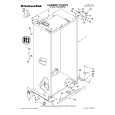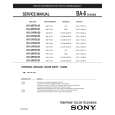SYNTHESIS TUTORIAL
Elements of a sound - Oscillators and waveforms
It is recommended that this chapter is read carefully if Analogue sound synthesis is an unfamiliar subject. Users familiar with this subject can skip this chapter and move on to the chapter - MIDI Tutorial on Page 15.
Volume Wave A is louder than Wave B but is the same pitch
Wave A
Wave B
Elements of a sound
To gain an understanding of how a Synthesizer generates sound it is helpful to have an understanding of the components that make up a sound, be it musical or non musical. The only way that a sound may be detected is by air vibrating the eardrum in a regular, periodic manner. The brain interprets these vibrations (very accurately) into one of an infinite number of different types of sound. Remarkably, any sound may be described by just three terms, and all sounds always* have them. They are : * Volume * Pitch * Tone What makes one sound different to another is the proportion of these three qualities initially present in the sound and how these three terms change throughout the duration of the sound. With a musical synthesizer, we deliberately set out to have precise control over these three terms and, in particular, how they can be changed throughout the duration of the sound. These terms are often given different names, Volume is referred to as Amplitude, Pitch as Frequency and Tone as Timbre. Pitch Taking the example of air vibrating the ear drum, the pitch is determined by how fast the vibrations are. For an adult human, the lowest vibration perceived as sound is about twenty times a second, which the brain interprets as a bass type sound, and the highest is many thousands of times a second, which the brain interprets as an extreme treble type sound. Having shown that just three elements make up any sound, these elements now have to be related to a Musical synthesizer. It is logical that a different section of the Synthesizer �Synthesizes� (or creates) these different elements. One section of the synthesizer, the Oscillators provide raw waveforms which provide the pitch of the sound along with its raw harmonic content (tone). These signals are then mixed together into a section called the Mixer and the mixed oscillator signal is then fed into a section named the Filter which is responsible for further altering the tone of the sound. It does this by removing (filtering) certain undesired harmonic frequencies. Lastly, the filtered signal is fed into a final section, the Amplifier which determines the final volume of the sound.
Oscillators
Mixer
Filter
Amplifier
Audio path of the main Synthesizer blocks
Additional synthesizer sections; LFOs and Envelopes provide ways of altering the pitch, tone and volume of a sound by interacting with the Oscillators, Filter and Amplifier, providing changes in the character of the sound which can evolve over time. Because LFOs and Envelopes only purpose is to control (modulate) the other synthesizer sections, they are commonly known as �modulators�. These various synthesizer sections will now be covered in more detail.
Wave B is twice the pitch of Wave A Wave A Wave B
Oscillators and waveforms
Time
If the number of peaks in the two waveforms (vibrations) are counted, it will be seen that there are exactly twice as many peaks in Wave B as in Wave A. (Wave B is actually an octave higher in pitch than Wave A). It is the number of vibrations in a given period that determines the pitch of a sound. This is the reason that pitch is sometimes referred to as frequency. It is the frequency of the waveform peaks which are counted during a given period of time. Tone Musical sounds consist of several different related pitches occurring simultaneously. The loudest is referred to as the �Fundamental� pitch and corresponds to the perceived note of the sound. Pitches related to the fundamental are called harmonics. The relative loudness of these harmonics compared to the loudness of all the other harmonics (including the fundamental) determines the tone or �Timbre� of the sound. Consider two instruments such as a harpsichord and a piano playing the same note on the keyboard and at equal volume. Despite having the same volume and pitch, the instruments would still sound distinctly different. This is because the harmonics present in a piano sound are different to those found in a harpsichord sound. Volume Volume, which is referred to as the amplitude or loudness of the sound is determined by how large the vibrations are. Very simply, listening to a piano from a metre away would sound louder than if it were fifty metres away.
The Oscillator is really the heartbeat of the Synthesizer. It generates an electronic wave (which creates the vibrations). This Waveform is produced at a controllable musical pitch, initially determined by the note played on the keyboard or contained in a received MIDI note message. The initial distinctive tone or timbre of the waveform is actually determined by the wave�s shape. Many years ago, pioneers of musical synthesis discovered that just a few distinctive waves contained many of the most useful harmonics for musical synthesis. The names of these waves reflect their actual shape when viewed on an instrument known as an Oscilloscope, and are known as, Sine waves, Square waves, Sawtooth waves, Triangle waves and Noise Waves. Each one has a specific fixed amount of musically related harmonics (except noise waves) which can be manipulated by further sections of the Synthesizer.
�9�



